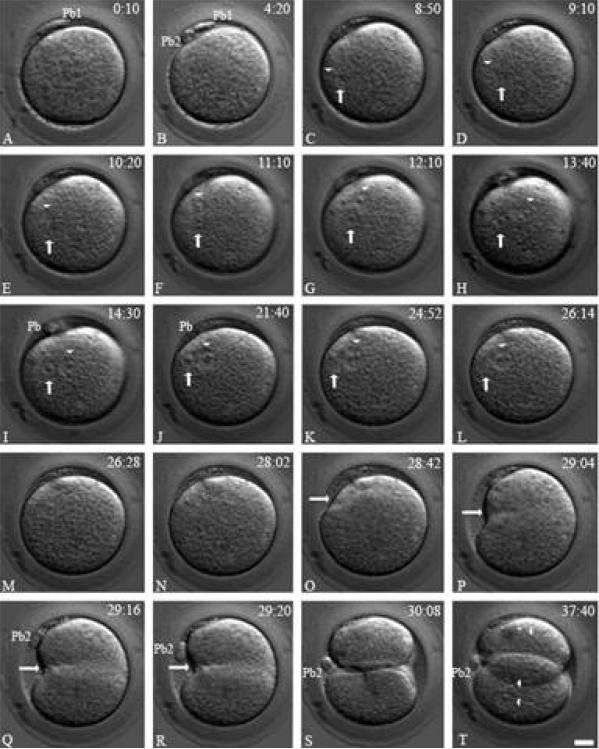Figure 2.
Time-lapse Video Microscopy of Baboon ICSI Fertilization. A: ICSI inseminated oocyte about 10 minutes post sperm injection. The first polar body is visible at the top (Pb1). B: within 4hr:20 min, the second polar body (Pb2) extrudes as the female pronucleus begins migration to the male (not shown). C: the apposed female (arrowhead) and male (arrow) pronuclei align eccentrically near the cortical region by 8hr: 50min within the activated cytoplasm. D-I : over the next 4.5 hrs, the tightly apposed male (arrows) and female pronuclei (arrowheads) begin to reorient within the activated egg's cytoplasm, rotating over 90° as pronuclear growth continues. J-K: as zygotic development continues, the apposed male and female pronuclei slightly shift towards the adjacent cortical region, with the male pronucleus (arrows) closest to the cortex and the female pronucleus (arrowheads) distal. Note the radial alignment of the pronuclei with the overlying cortex and nearly 90° alignment with the polar bodies (I-K; Pb). L-M: by 26hr:14min, nuclear envelope breakdown occurs in the male pronucleus (L: arrow) followed by female pronuclear envelop breakdown (M: arrowhead) 14 minutes later. N: mitotic zygote with no visible pronuclei at 28hr:02min. O-S: approximately 40 minutes later, an unequal cleavage furrow forms, beginning nearest the cortical region adjacent to the last position of the male pronucleus (arrows) and continuing to the opposite cortex. Note the second polar body (Pb2), tethered to the zygote, rotates into the cleavage furrow to lie between the daughter blastomeres (S: Pb2). T: daughter cells showing reformation of two nuclei in one blastomere (bottom: two arrowheads) and one nucleus in the other blastomere (upper: one arrowhead). Upper right: stage in hours: minutes post ICSI fertilization. Pb1: first polar body; Pb2: second polar body. Bar= 20 μm.

